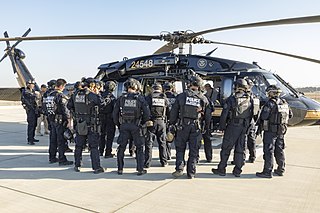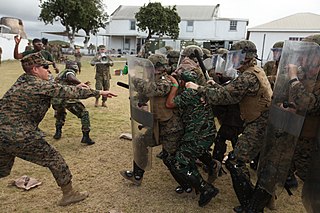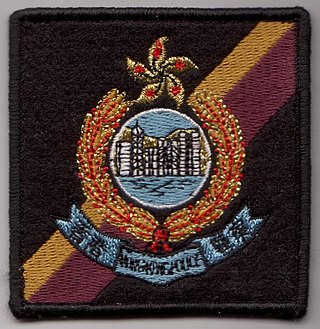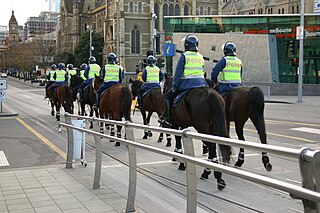
In the United States, a SWAT team is a generic term for a police tactical unit that uses specialized or military equipment and tactics.

The Metropolitan Police Service (MPS), formerly and still commonly referred to as the Metropolitan Police, is the territorial police force responsible for law enforcement and the prevention of crime within the ceremonial county of Greater London. In addition, it is responsible for some specialised matters throughout the United Kingdom, including national counter-terrorism measures and the protection of specific people, such as the monarch and other members of the royal family, members of the government, and other officials.

Riot control measures are used by law enforcement, military, paramilitary or security forces to control, disperse, and arrest people who are involved in a riot, unlawful demonstration or unlawful protest.

The New South Wales Police Force is a law enforcement agency of the state of New South Wales, Australia, established in 1862. With more than 18,000 police, it is the largest police organisation in Australia, policing an area of 801,600 square kilometres with a population of more than 8.2 million people.

Victoria Police is the primary law enforcement agency of the Australian state of Victoria. It was formed in 1853 and currently operates under the Victoria Police Act 2013.

A police car is a ground vehicle used by police and law enforcement for transportation during patrols and responses to calls for service. A type of emergency vehicle, police cars are used by police officers to patrol a beat, quickly reach incident scenes, and transport and temporarily detain suspects, all while establishing a police presence and providing visible crime deterrence.
The Special Operations Group (SOG) is the police tactical group of the Victoria Police. The SOG was Australia's first full time and dedicated police tactical group when it formed in 1977.

The Police Tactical Unit is a unit within the Hong Kong Police Force which provides an immediate manpower reserve for use in large-scale emergencies. Unit companies are attached to all land Regions and are available for internal security, crowd control, anti-crime operations, disaster response and riot control throughout Hong Kong. The PTU is often referred as the 'Blue Berets', which is in reference to the blue berets worn as part of the uniform.
A Police Support Unit or PSU is a unit of police officers who have undergone specialist tactical training in Public Order and Riot Control.

The Public Order and Riot Squad (PORS) is the full-time riot squad of the New South Wales Police Force. PORS reports via the Counter Terrorism and Special Tactics Command to the Deputy Commissioner Investigations and Counter Terrorism.
The Critical Incident Response Team (CIRT) is a specialist unit of the Victoria Police that provides assistance to general duties police, including a negotiator capability, to resolve high risk incidents utilising specialist tactics and equipment. CIRT was formed to conduct regular patrols of metropolitan Melbourne 24-hours, seven-day-per-week, ready to rapidly respond to incidents in Melbourne, and if necessary, in regional Victoria, by a small team of officers. CIRT has evolved to include conducting planned operations for high risk searches and arrests.

The Royal Malaysia Police, is a (primarily) uniformed national and federal police force in Malaysia. The force is a centralised organisation, and its headquarters are located at Bukit Aman, Kuala Lumpur. The police force is led by an Inspector-General of Police (IGP) who, as of 23 June 2023, is Razarudin Husain.

The Federal Reserve Unit, or better known by the abbreviation as FRU, is a riot control force and a paramilitary special response team that can be deployed at any time to engage in any emergency or public unrest in Malaysia.

Egyptian National Police or ENP is a department of the Ministry of Interior of Egypt.

The 1982 demonstrations in Poland refers to anti-government street demonstrations organized by underground Solidarity to commemorate the second anniversary of the Gdańsk Agreement. The bloodiest protest occurred in southwestern Poland, in the town of Lubin, on August 31, 1982. The Lubin demonstration resulted in three protesters killed by Communist services, and an unknown number of wounded. On the same day, rallies and demonstrations took place in several cities across the country. According to Solidarity sources, there were four more victims—in Wrocław, Gdańsk, Nowa Huta, and Toruń. According to official government sources, there were demonstrations in 66 cities.

The militarization of police is the use of military equipment and tactics by law enforcement officers. This includes the use of armored personnel carriers (APCs), assault rifles, submachine guns, flashbang grenades, sniper rifles, and SWAT teams. The militarization of law enforcement is also associated with intelligence agency–style information gathering aimed at the public and political activists and with a more aggressive style of law enforcement. Criminal justice professor Peter Kraska has defined militarization of police as "the process whereby civilian police increasingly draw from, and pattern themselves around, the tenets of militarism and the military model".

Riot Police Unit are the rapid reaction forces of Japanese prefectural police. These units are not only riot police, but a type of emergency service unit to maintain public order against large civil disorder, disaster response, or other emergency situations as the key units of Japanese law enforcement for crisis management. They are operated by prefectural police headquarters (PPH) under the supervision of the Security Bureau of the National Police Agency.

The Mounted Branch is the mounted police unit of Victoria Police who operate on horseback. The Mounted Branch can trace its origins to units formed more than 180 years ago.
Starting in May 2020, protests following the murder of George Floyd were held in the city of Portland, Oregon, concurrent with protests in other cities in the United States and around the world. By July 2020, many of the protests, which had been held every day since May 28, drew more than 1,000 participants. Protests continued into August, September, and October 2020, often drawing hundreds.

Protests and civil disorder occurred in reaction to the killing of Daunte Wright on April 11, 2021. Wright, a 20-year-old Black man, was fatally shot by police officer Kimberly Potter during a traffic stop in Brooklyn Center, Minnesota, United States. Protests that first began in Brooklyn Center spread to other locations in the Minneapolis–Saint Paul metropolitan area and then to other cities in the United States. Several nights of civil disorder in Brooklyn Center and adjacent cities resulted in sporadic looting and damage to a few hundred properties, including four businesses that were set on fire.



















